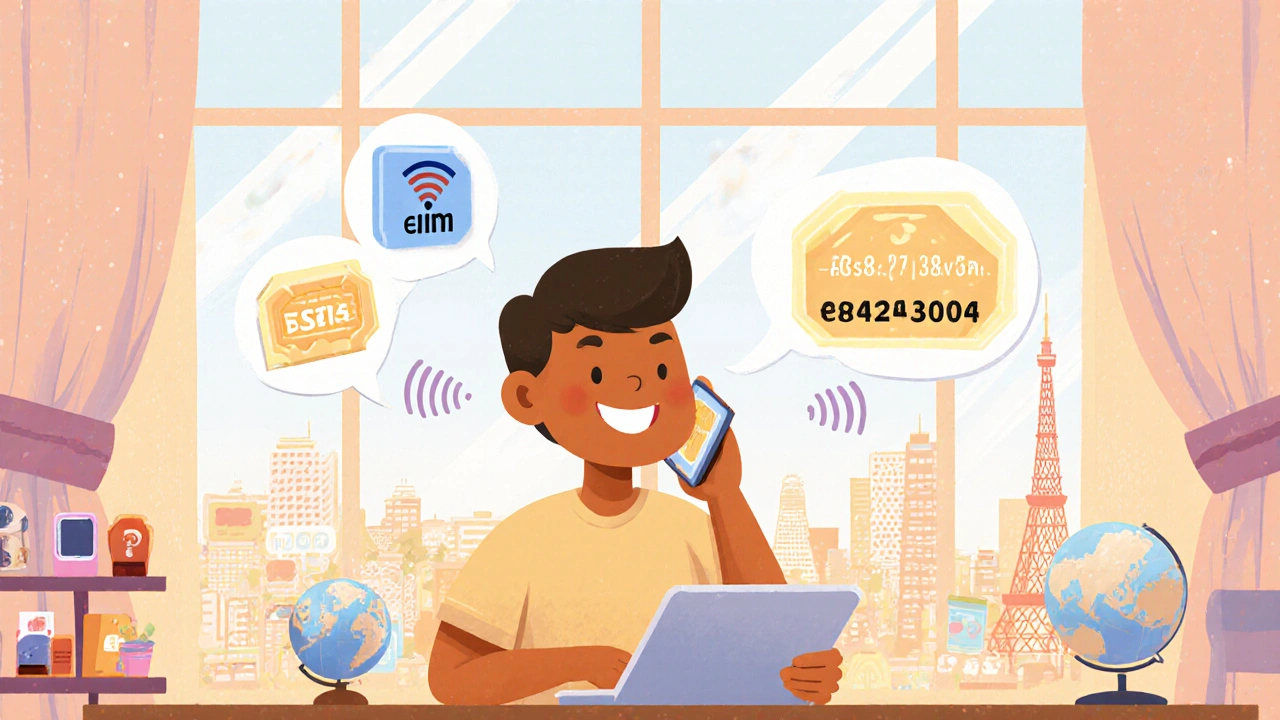Stuck paying $10 a minute to call home while sitting in a café in Tokyo? Or worse-your client in Berlin can’t reach you because your US number won’t ring through? You’re not alone. In 2025, VoIP for travel isn’t a niche trick anymore-it’s the standard way business travelers and digital nomads stay connected without getting billed into bankruptcy.
Forget old-school roaming packages. They’re expensive, slow, and outdated. Today, you can get a local number in 120+ countries, make calls for pennies per minute, and switch between Wi-Fi and cellular without dropping a single call-all without touching a physical SIM card. Here’s how to make it work for you.
Why VoIP Beats Traditional Roaming
Traditional roaming charges are a scam. Even with "unlimited" plans, you’re still paying $0.25 to $1.50 per minute to call internationally. And if you’re calling a mobile number? That’s often double. In 2025, the average business traveler spends over $800 a year on international calling through their carrier.
VoIP changes that. By using your internet connection-Wi-Fi or mobile data-you bypass cellular networks entirely. That means calls to the US from Thailand cost the same as calls to your neighbor: a few cents per minute. Some services charge as little as $0.01 per minute to over 200 countries. That’s a 90%+ savings.
But it’s not just about cost. With VoIP, you keep your US (or UK, or German) number while abroad. Clients call you like you’re still in the office. You can receive calls on your laptop, tablet, or phone-all ring the same number. No more "I can’t reach you on your number" messages.
What You Need: eSIMs, Apps, and Internet
To use VoIP while traveling, you need three things: a way to get internet, a VoIP app, and ideally, a local data plan. That’s where eSIMs come in.
An eSIM is a digital SIM card built into your phone. No plastic card to swap. Just download a data plan from providers like Airalo, Holafly, or Nomad, and you’re online in minutes. Most modern phones (iPhone XS and later, Samsung S20 and newer, Google Pixel 3 and up) support eSIMs.
Pair that with a VoIP app, and you’ve got a full phone system. You don’t need to keep your original carrier’s data plan running. Just turn off cellular calling and rely on Wi-Fi or your eSIM data. This cuts your monthly bill by 70-90%.
Internet speed matters too. For clear calls, you need at least 1 Mbps upload and download. On 4G or Wi-Fi 6, most VoIP apps deliver crystal-clear audio with a Mean Opinion Score (MOS) of 4.5 out of 5. On shaky connections? Expect drops. Always have a backup Wi-Fi spot ready.
Best VoIP Apps for Travel in 2025
Not all VoIP apps are made for travelers. Some are built for offices. Others are for friends chatting. Here’s what actually works on the road.
- Google Voice: Best for personal use. $0.01/min to 200+ countries. Requires a US number (you can port yours in). Works great with eSIMs. No monthly fee if you only use it for calls.
- Roamless: Built for travelers. $0.01/min to 100+ countries. No subscription. Local numbers in 45+ countries. Auto-switches between Wi-Fi and cellular. Used by 80% of digital nomads on Reddit’s r/digitalnomad.
- Allo: Best for professionals. $24.99/month. Gives you local numbers in 45 countries. AI receptionist answers calls in 12 languages. Great if you want to sound local in Germany, Japan, or Brazil.
- OpenPhone: Best for small teams. $16/month. Clean interface, seamless mobile integration. Unlimited calling to US, Canada, Mexico. Works well with Slack and Zoom.
- WhatsApp / Viber: Free for calls between users. But not reliable for business. If your client doesn’t use WhatsApp, you’re out of luck.
Enterprise tools like RingCentral and Zoom Phone are great for companies-but overkill if you’re just traveling alone. They charge $20+ per user and lock you into long contracts. For most travelers, simpler is better.

How to Get a Local Number Abroad
Want to give a Berlin client a local number so they don’t think you’re calling from the other side of the world? VoIP makes this easy.
Services like Allo and Roamless let you rent virtual numbers in over 120 countries. You don’t need to live there. You don’t need a bank account. Just pick a city-London, Tokyo, Sydney-and get a number with that area code. Calls to that number ring your phone, no matter where you are.
Here’s how it works:
- Sign up for a VoIP service that offers local numbers.
- Choose a country and city (e.g., "Berlin, Germany").
- Pay a small monthly fee (often $1-$5) or a one-time charge.
- Start receiving calls on that number.
Use it for client outreach, customer support, or even to book hotels that don’t accept foreign numbers. It builds trust. People are 63% more likely to respond to a local number, according to Forrester’s 2025 study on international communication.
Dialing Tips: Don’t Get Blocked
One of the biggest mistakes travelers make? Dialing wrong.
VoIP apps handle international dialing differently than your phone’s native dialer. You don’t need to dial 011 (the US exit code) anymore. Just use the plus sign (+) followed by the country code and number.
Example: Calling London from Mexico? Type: +44 20 1234 5678. That’s it. No extra codes. No confusing menus.
But watch out for mobile vs. landline charges. Some "unlimited" plans cover landlines only. Calling a UK mobile? That’s $0.05/min on Google Voice, but $0.20 on some enterprise plans. Always check the fine print.
Use apps with built-in number validators. Allo and Roamless automatically fix formatting if you type a number wrong. Save yourself the embarrassment of calling a wrong number and getting a busy signal.
Where VoIP Doesn’t Work (And How to Work Around It)
VoIP is legal in 185 countries. But not everywhere.
China blocks most VoIP apps. UAE only allows calls through Etisalat and du-approved services. India requires local data storage for VoIP providers. In these places, your app might not connect at all.
Here’s how to handle it:
- China: Use a VPN before installing VoIP apps. Or rely on WeChat, which works inside China. Keep a local Chinese SIM for emergencies.
- UAE: Only use approved services like BOTIM or C'Me. Avoid WhatsApp calling. Stick to SMS or local calls.
- India: Use Google Voice or OpenPhone-they comply with local rules. Avoid apps that route calls through servers outside India.
Always test your setup before landing. Try calling a friend in the country you’re visiting. If it doesn’t work, switch to a local SIM with a calling plan.

Pro Tips for Stress-Free Travel Calling
- Always connect to Wi-Fi first. It uses 92% less data than cellular. Saves your eSIM plan for emergencies.
- Use Wi-Fi calling as primary, cellular data as backup. Roamless users report 67% fewer dropped calls with this setup.
- Turn off cellular voice. Go to Settings > Cellular > Voice & Data > Turn off "Voice Roaming". Let VoIP handle everything.
- Save numbers in E.164 format: +CountryCode AreaCode Number. No spaces, no dashes. Your phone will auto-format them.
- Test your number before a big call. Call your own voicemail. Make sure it rings.
- Carry a backup device. A cheap Android tablet with eSIM and Google Voice can save you if your phone dies.
One nomad in Portugal saved $1,422 last year just by switching from AT&T roaming to Google Voice + Airalo eSIM. That’s a free vacation. You can do the same.
What to Avoid
Don’t fall for these traps:
- "Unlimited international calling" plans that only cover 20-50 countries. If you’re going to Vietnam, Kenya, or Brazil, they won’t work.
- Enterprise VoIP services that charge $25/month for features you’ll never use (CRM integrations, call recording, IVR menus).
- Using WhatsApp for business. It’s unreliable. Clients don’t always respond. And you can’t get a business number.
- Ignoring country-specific dialing rules. UK mobile numbers are 10 digits after +44. Brazil is 11. Get it wrong? You’ll get a busy signal.
Stick to per-minute pricing. It’s cheaper, more transparent, and covers more places.
Can I use VoIP without an eSIM?
Yes, but you’ll need Wi-Fi everywhere. Without an eSIM, you’re stuck relying on hotel, café, or airport Wi-Fi. That’s risky. If the Wi-Fi goes down, you lose your connection. An eSIM gives you cellular backup. For serious travelers, eSIM + VoIP is the only reliable combo.
Do I need to change my phone number when I travel?
No. With VoIP, you keep your original number. You can also add a local number in the country you’re visiting. Clients can call you on either number. Your home number stays active. No one needs to know you’re abroad.
Is VoIP legal in every country?
It’s legal in 185 countries. But not in China, UAE, and a few others. In China, most apps like WhatsApp and Skype are blocked. In the UAE, only government-approved apps work. Always check the rules before you travel. Use a VPN in restricted countries, or rely on local SIMs with calling plans.
How much does VoIP cost per minute?
It varies. Google Voice and Roamless charge $0.01 per minute to most countries. Some services charge $0.05-$0.15 for mobile numbers in Europe or Asia. Enterprise plans like RingCentral charge $0.02-$0.08 per minute, but require monthly subscriptions. Per-minute plans are cheaper than unlimited if you call more than 5 countries.
Will my calls be secure?
Most VoIP apps use end-to-end encryption (WhatsApp, Signal, Zoom). Google Voice and OpenPhone use TLS and SRTP encryption. Avoid free apps that don’t mention security. If you’re handling sensitive business info, stick to trusted providers with clear encryption policies.
Final Takeaway
Traveling with VoIP isn’t about saving a few bucks. It’s about staying professional, connected, and in control. In 2025, the tools are simple, cheap, and powerful. You don’t need to be a tech expert. Just pick a service, get an eSIM, set up a local number, and start calling like you’re still at your desk.
The future of international communication isn’t roaming charges. It’s internet, numbers, and freedom. You’re already holding the keys.
